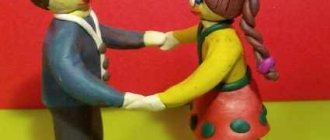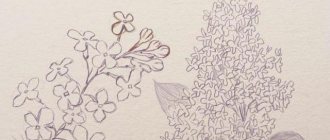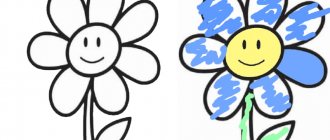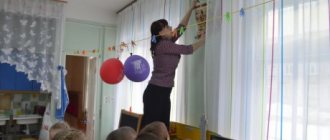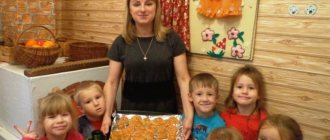Lesson notes on decorative drawing
In the preparatory group, standard long-term planning provides for one drawing lesson per week. The total duration of continuous activity should not exceed 20–25 minutes; methodological manuals recommend performing physical exercises (finger, breathing, motor exercises) for 5 minutes for relaxation and prevention of mental and physical fatigue in children.
Organizational part of the lesson
Lesson outline:
- Organizational part (3–5 minutes). The practical part of the lesson can be preceded not only by reading fairy tales, poems or riddles, but also by watching educational pictures, presentations, a fragment of an educational film or cartoon. The information and familiarization stage involves awakening children's interest in the task and becoming familiar with the elements of painting for decorating objects. It is necessary to include surprise moments, elements of theatrical or didactic games that stimulate creative activity and create a psychologically comfortable environment.
- Practical part - the teacher explains the essence of the task (3-5 minutes). Older preschoolers are given more freedom in the drawing process; showing a sample prepared by the teacher is used less and less for sketching, more often to demonstrate new techniques or clarify the sequence of work. Techniques that have already been mastered do not require additional demonstration.
- Independent work of children (15–20 minutes). The teacher prompts and helps if children have difficulties or misunderstandings while drawing.
- The final part is the analysis and assessment by children of their works and the drawings of their comrades. Children are taught to formulate their point of view with reason and verbally express the aesthetic perception of creative works (3-5 minutes).
Lesson summary on the topic “Blue Gzhel” (author E. Ulimova)
| Goal of the work: introducing older preschoolers to the basics of arts and crafts Equipment:
Items of decorative and applied art (Zhostovo trays, Palekh boxes, Filimonov whistles, Khokhloma dishes, nesting dolls (Semyonov, etc.), an exhibition of Gzhel dishes and dolls in “Gzhel” costumes (At the beginning of the lesson, it is covered with blue and white chiffon), Cut-out pictures for the didactic game “Assemble the picture and guess the painting”, Drawing of Gzhel dishes, painted over with white paint so that blue patterns appear, contour blanks of Gzhel dishes, blue gouache, brushes No. 1 and 2. 1. Organizational part. Educator. Guys, today we with you we will take a journey into the world of beauty, goodness, into the world of amazing creations of folk craftsmen. And for this we must smile at each other and say hello. Hello, golden sun! Hello, blue sky! Hello, light breeze! Hello, little leaf! We live in my native land. I greet you all! (Children repeat the movements after the teacher) Educator. Folk art has its roots in ancient times. The people have always had a need to decorate their life, the things that constantly surrounded them. What did folk artists paint? (Children list the objects lying on the table) All these beautiful and useful things were made by folk craftsmen with their own hands. They gave us and all the people a real holiday. They believe that all these things are not only necessary in everyday life, but also decorate our lives. Please come here. Here are the pieces of the mosaic. Put the pieces together to create a whole picture and see what you come up with. Didactic game “Collect the picture and guess the painting” Conversation during the game. What's in your picture? What kind of painting is this? What elements of Gorodets painting can be seen in this picture? What kind of dishes were painted in Gorodets? How do Filimonov toys differ from all others? What patterns were drawn on Filimonov whistles? In what village were such beautiful toys made? What elements make up Dymkovo patterns? And I have prepared a very beautiful painting for you. Look at the magical blue Gzhel patterns on her. Oh, what is this, I don’t understand anything? Who did this? He painted over all the blue patterns, as if he had frozen them...... Teacher. Gee. Winter covered blue Gzhel with snow. (we approach the tables). And our dishes, which we painted yesterday, were covered with snowflakes and no patterns were visible. There’s not even anything to surprise moms and dads with. We will have to work hard again, to return the patterns to the dishes. Maybe then Gzhel will return to us. 2. Practical part. I think that this will not be difficult for you to do, because you are real craftsmen, masters of your craft. First, let's remember what the painting is called, the elements of which we used yesterday when painting dishes? (Gzhel painting) What paint do we need? What brush techniques did you use when painting? (Drawing with the whole brush, the tip of the brush, dabbing, smearing) 3. Independent work of children. Educator. Now sit back and get to work. Don't rush, remember the proverbs that the Russian people came up with about those who are in a hurry. (If you hurry, you will make people laugh. If you do it quickly, you will redo it.) 4. The final part. Bring your finished works to the exhibition. Analysis of works.
|
Decorative drawing in senior and preparatory groups
Decorative drawing
in the senior and preparatory group of preschool educational institutions
Decorative drawing is the creation of patterns and other decorations for books, household items, clothing, etc. The basis of decorative drawing, like other types, is the study of nature, the use of its forms, colors in the creative process. However, real forms for patterns are not taken ready-made, but creatively processed. The combination of processed elements in a certain rhythmic sequence creates a pattern.
In preschool age, a child needs images, sounds, colors. This is the building material for his basic mental functions, well and richly formed emotional skills, and worldview as a whole. Decorative art carries all this in abundance.
Currently, decorative drawing is widely used in the artistic education of children. Authentic examples of decorative creativity and modern works of decorative art are used in classes and in the design of kindergartens. Decorative and applied art is designed to decorate, ennoble and transform the objective world.
Acquaintance with decorative and applied arts helps to solve the most difficult problems - the expansion and development of children's artistic ideas, spiritual needs, skills in appreciating works of art, the development of artistic taste, and an aesthetic attitude towards the environment.
The arts and crafts are fundamentally taciturn. The surrounding reality here is transformed into clear and succinct symbols. Decorative compositions are created, emphasized by expressive lines of flat silhouettes. Even the master’s use of a single detail of an object or its simplified stylized symbol gives a complete picture of the object.
1.Tasks and content of training in senior and
preparatory group
In kindergarten, drawing takes a leading place in teaching children the fine arts and includes three types: drawing of individual objects, plot and decorative. Each of them has specific tasks that determine the program material and the content of the work. The main task of teaching drawing is to help children understand the surrounding reality, develop their powers of observation, cultivate a sense of beauty and teach techniques of depiction; at the same time, the main task of visual activity is carried out - the formation of children’s creative abilities in creating expressive images of various objects using visual means available for a given age.
The general objectives of learning to draw individual objects for all age groups are the following:
- teach how to depict the shape and structure of an object, convey the proportional relationships of parts, changes due to simple movement;
- teach the depiction of some characteristic details that make the image expressive and imaginative;
- convey the color of an object in accordance with its content and the nature of the image;
- develop technical skills in drawing with pencils, paints and other materials.
These tasks are revealed and specified in the program material for each age group. The program material is distributed across quarters, which facilitates its sequential completion and accounting for the time required to master a new task and consolidate skills.
Education for older children is aimed at improving visual skills and developing the ability to create expressive images using various means of representation.
The learning objectives are:
- teach how to correctly convey the shape of an object, its characteristics, relative size and position of parts;
- teach how to convey simple movements in drawing;
- develop and improve the sense of color;
- develop technical skills in working with pencil (shading methods) and paints (brush techniques);
- teach drawing techniques with crayons, charcoal, sanguine, and watercolors.
Increasing the complexity of educational tasks is justified by the further development of children. Their experience expands significantly; they acquire a lot of new knowledge through observing the life around them, reading fiction, stories from adults, etc. It becomes possible for them to draw on topics not related to direct perceptions (fairy-tale characters), depict objects they have not seen (for example, animals hot countries, etc.).
To convey the characteristic colors of objects in the older group, the set of colors with which children work is increased. In this group, preschoolers become familiar with the primary colors of the spectrum and learn to use their beautiful combinations in drawing.
In addition to colored pencils, children in the older group use a simple pencil to preliminary draw the main parts of the object.
The ability to create an expressive image is associated with the development of the ability to notice the characteristic features of objects (for example, when drawing from life branches with buds, leaves, snowdrops, and in the summer, various types of mushrooms, berries, flowers, butterflies). If in the middle group objects with a symmetrical arrangement of parts were selected for drawing from life, then in the older group a more complex nature is used, sometimes without symmetry.
The preparatory group completes the training of preschoolers in fine art skills. Children should come to school with basic skills in drawing objects from life and from memory, the ability to see a variety of shapes, colors, and the position of objects in space in the life around them.
The objectives of training in the preparatory group are the following:
- teach the depiction of the structure, size, proportions, characteristic features of objects from life and from representation;
- teach to convey a wealth of shapes and colors, create expressive images;
- develop compositional skills (location of an object on a sheet depending on the nature of the shape and size of the object);
- develop a sense of color (the ability to convey different shades of the same color);
- develop technical skills (the ability to mix paints to obtain different colors and their shades;
- apply pencil strokes or brush strokes to the shape of the object).
Six-year-old children have fairly well developed analytical thinking. They can highlight both common features inherent in objects of the same type, and individual characteristics that distinguish one object from another.
For example, children of the preparatory group are taught to see and draw trees of different species in the depiction of various trees, where all these common features (trunk, branches, leaves) are somewhat unique: in a Christmas tree, the trunk gradually narrows upward and ends with a thin sharp tip, and in deciduous trees it also tapers, but at the top it branches and ends in many small branches; the birch has thick branches going up, and long thin branches hang down, and the linden has thin branches located parallel to the ground.
There are bent trees, with forked trunks, young and old. The ability to see this diversity and convey it in a drawing develops in children the ability to create expressive images of nature.
Preschoolers master the ability to convey the characteristic features of the structure and shape of objects by drawing from life a variety of objects, initially simple in shape and structure: Christmas tree and pine branches, fish, birds, dolls.
Based on existing ideas about real objects, children draw fairy-tale characters: the Firebird, the Little Humpbacked Horse, Morozko, Baba Yaga, etc. Drawing fairy-tale characters contributes to the development of creative imagination.
In the preparatory group, children begin drawing with a preliminary sketch, in which the main parts are outlined first, and then the details are specified. Using a sketch forces the child to carefully analyze the nature, highlight the main thing in it, coordinate the details, and plan his work.
2.Methods and techniques for teaching decorative drawing in senior and preparatory groups
The teacher’s work with preschoolers when organizing classes is based on the following learning objectives:
1. Development in children of the prerequisites for a sense of patriotism, love, respect for the Motherland and people.
2. Formation of children's interest in folk art; understanding its features; desire to know the art of the local region, to distinguish the styles of the most famous types of decorative painting (Khokhloma, Gorodets, Dymkovo, etc.).
3. Formation in children of a desire to engage in such activities at the suggestion of adults and on their own initiative.
4. Formation of generalized knowledge and corresponding visual skills: children’s mastery of characteristic elements, color, compositions, patterns of a particular painting; the ability to create expressive patterns on paper of different formats and on three-dimensional objects; cultivating a sense of form, rhythm, and symmetry.
5. Fostering activity, independence, initiative, and creativity when creating expressive patterns.
These general objectives can be specified by age group.
Principles of training:
1. Teaching children decorative drawing based on folk decorative art. This is explained by the fact that all the techniques of decorative activity are represented in this art and it represents highly artistic examples worthy of imitation.
2. Teaching children decorative and artistic activities based on close, native art of the local region.
3. Decorative drawing classes are considered as an element of the general system of educational work aimed at personal development through the means of folk applied art.
4. Training in decorative and artistic activities must be carried out using authentic objects of folk art.
5. The relationship between all types of decorative and artistic activities (drawing, modeling, appliqué).
6. The learning process involves a limited connection in the formation of knowledge, feelings and active action (in the form of one’s own visual activity).
The methodology for working with children should be carried out simultaneously in two directions:
1. General educational work based on materials of folk decorative art.
2. Special training for children in relevant activities in the classroom.
The system-forming beginning of work with children (the first direction) is the formation of emotional and intellectual experience in preschoolers, which contributes to the emergence of effective motives for children’s own visual activity and its meaningful development.
An addition to such work with children can be watching films, art albums, and postcards on relevant topics. Reading literature or a story that reveals in an accessible and interesting form a small amount of information about the history of artistic craft.
Without special training, it is difficult for children to master decorative patterns based on folk painting. Therefore, it is necessary to develop a series of classes aimed at teaching children how to create a pattern (second direction). The cycle of such classes is based on the content of general educational work outlined above, coexists and interacts with it, since it is in it that the basis is laid for creating in children appropriate, morally valuable motives for activity in the classroom. This cycle of classes is also built systematically. It is based on a gradual complication of the content (visual and expressive means), the nature of cognitive activity, and therefore the degree of independence and creativity of children. Therefore, the use of teaching methods and techniques should also be systematic.
Color is one of the expressive means in decorative drawing. Its development is subject to the laws of color of a certain art, since for well-known traditional types of folk painting they are definite and typical.
The work system uses a combination of different types of classes, and the learning process accordingly provides for the initial familiarization of children with methods of representation, variable exercise in their application, and, finally, a creative solution by children to a visual task.
The system of tasks corresponds to a system of teaching methods and techniques. The relationship with general educational work does not exclude, but presupposes the inclusion in it, immediately before classes (a day or two) of targeted preliminary work with children. Its essence is the formation of “living” ideas and visual images in children.
In the senior and preparatory groups, a deeper acquaintance with folk decorative art occurs, and children develop respect for this work. Among the tasks of mastering the corresponding visual skills, there appears the task of teaching new elements of a pattern (wavy line, arcs, dots, flowers, leaves, berries). Children master characteristic color combinations, pattern elements, learn to make patterns on paper of different shapes, silhouette images of objects (jug, mittens, dress, etc.). The experience gained by children in the previous group makes it possible to set tasks that require preschoolers to master generalized knowledge and skills and develop greater independence and creativity. Taking as a basis one, the closest type of folk art (for example, Gorodets painting), a wide range of problems should be solved:
1. To develop children’s interest in Gorodets painting, surprise, admiration for the beauty and unusual design of products, ease of use, and aesthetic design; desire to learn as much as possible about this type of folk art.
2. Introduce children to the origins of the art of Gorodets masters and a brief history.
3. Create a desire to learn how to draw Gorodets patterns. Introduce the characteristic elements (“kupavka”, “daisy”, “bud”, “rosan”, “bull’s eye”, characteristic leaves.). Introduce the colors typical of Gorodets patterns and pattern compositions.
4. Encourage children to peer into patterns, teach the sequence of analysis: the largest elements and their location in the overall composition; features of a particular element; highlighting other elements, their location, features; color; expressive techniques of “animation” on a product, where the compositional center is the most important flower.
5. Teach children the preliminary design of a decorative pattern (analysis of the original shape on which the pattern will be located; determination of the general composition: where it is best to place decoration elements; selection of elements; determination of color; determination of the sequence of the general image; sequence of the image of one element, for example, a bathtub).
6. To develop generalized knowledge and skills in decorative drawing for this type of painting (Gorodets patterns).
7. To develop the ability to creatively create an image based on a sense of form, selection and original combination of elements, color, in a unique composition.
8. To create a desire to share joy, successful work with other people, a desire to give a gift to family and friends, using your skills in decorative activities based on Gorodets painting.
According to the tasks, the teacher develops the content of general educational work with children and the system of classes.
Preschoolers have unstable memory and poorly developed fine motor skills of their fingers. Therefore, training is built from simple to complex. In the process of learning drawing techniques, children learn to select and combine colors with each other.
This way you can gradually move on to creativity. After children’s technical skills are formed, I begin to develop children’s creative imagination, using didactic games in their free time from classes that develop imagination, memory, and creative ability to analyze.
Conclusion
In classes in decorative and applied painting, aesthetic perception, presentation, and aesthetic feelings are developed. Sensory experience accumulates, speech is enriched. Children develop thought processes: comparison, analysis, synthesis, generalization. Recently, the importance of arts and crafts painting classes in kindergarten has been emphasized for the formation of collective forms of work, the ability to work together, act in concert, together, and provide assistance to comrades. The ability to rejoice in the successes of each student and the achievements of the entire group team develops. All this creates the basis for further education of genuine collectivism, mutual exactingness and, at the same time, comradely mutual assistance.
Teaching decorative and applied painting to preschoolers contains great potential for the comprehensive development of the child. However, these opportunities can be realized only when children gradually master this activity in accordance with their age characteristics and receive satisfaction from it.
The specificity of decorative and applied art, expressed in the unity of form and practical purpose of a decorative item, in the unity of labor skills, skills and artistic and aesthetic taste, allows for an integrated approach to the organization of arts and crafts classes in kindergarten, determines the organic unity of labor and aesthetic education of preschoolers . This unity is also due to the modern requirement of international standards in industrial products, which is expressed not only in a highly efficient level of the work process, but also in the requirements of technical aesthetics.
Bibliography
- Vasilenko V.M. Folk art / V.M. Vasilenko. – M., 1974. – 163 p.
- Kazakova T.G. Develop creativity in preschoolers: notes on drawing, modeling, appliqué classes: / T.G. Kazakova. – Moscow: Education, 1985. – 192 p.
- Korchinova O.V. Decorative and applied creativity in preschool institutions: / O.V. Korchinova – Rostov-on-Don: Phoenix. 2002. – 320 p.
- Methods of teaching visual arts and design: / ed. N.N. Sakulina, T.S. Komarova - M.: Education, 1979.
- Nazarova K.N. Gorodets miracles: / Rostov-on-Don: Malysh Publishing House. 1977. – 76 p.
- Nazarova K.N., Ordynskaya, T.N. Russian souvenir.: / M.: Advertising, 1973. - 80 p.
- Fundamentals of fine arts and methods of guiding children’s visual activities: A textbook for students of pedagogical institutes / V.B. Kosminskaya, N.B. Khalezova M.: Education. 1981.- 323 p.
- Drawing in kindergarten [Electronic resource]: https://www.detskiysad.ru/izo/teoria09.html
- Usupova A.P. Russian folk art for kindergarten: - M.: Education. 1972. – 150 p.
- Shevchuk, L.V. Children and folk art: book. for the teacher / L.V.Shevchuk. – M., 1985.- 240 p.
